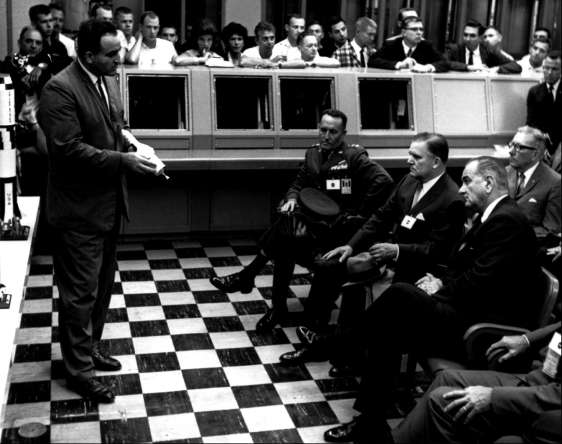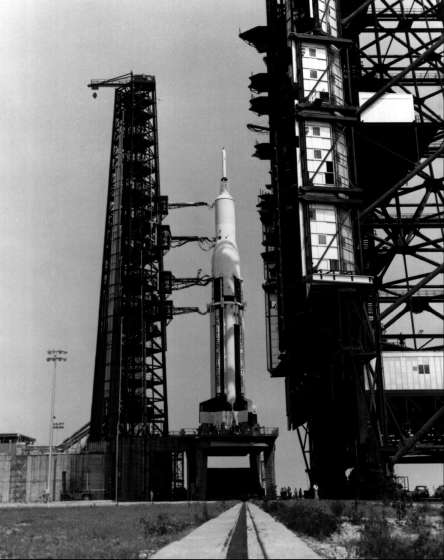
The Remaining Block II Launches,
SA-6 (28 May 1964)
Later Saturn I missions brought new requirements and major launch problems, but none of the subsequent operations dragged on like SA-5. Launch preparations for the remaining five Saturns averaged 91 days, 70 days less than the SA-5 operation. An Apollo boilerplate, duplicating the weight and external configuration of the fully equipped spacecraft, flew on the May 1964 launch of SA-6. Boilerplate 13, the payload for SA-6, was one of 30 spacecraft built by North American for preliminary Apollo tests. The Manned Spacecraft Center had already launched several boilerplates at White Sands Proving Grounds to test the spacecraft for land and water impact, parachute recovery, pad aborts, and water egress and flotation. SA-6 demonstrated the spacecraft's structural compatibility with a Saturn launch vehicle.42
The checkout of boilerplate 13 had begun in December 1963 when G. Merritt Preston, Director of Houston's Florida Operations, sent George T. Sasseen to North American's Downey, California, plant with a 40-man team. Sasseen's counterpart on the North American staff was project engineer Robert Gore. For two months the NASA-North American team subjected boilerplate 13 to a series of rigorous tests, from assembly line inspections to simulated flights. After the spacecraft was transferred to Florida, there were more tests in hangar AF. By early April the spacecraft team was ready to stack the boilerplate atop the Saturn I vehicle. During the next six weeks, the team resolved problems in the spacecraft cooling systems and in the mechanism for jettisoning the launch escape tower. Much time was spent checking telemetry and the 116 instrumented measurements that recorded structural and thermal responses.43
The 20 May launch date was postponed after liquid oxygen damaged a wire mesh screen during a test, causing fuel contamination. Six days later, a countdown proceeded satisfactorily until T-115 minutes, when a compressor in the environmental control system failed. The air conditioning gone, the temperature in the rocket's guidance system soon exceeded tolerance and the launch was scrubbed.44
On 28 May it seemed that Launch Vehicle Operations might postpone the third attempt. Liquid oxygen vapors, vented from the S-IV stage, obscured the line of sight from a ground theodolite to an optical window in the SA-6's instrument unit. Winds blew the vapor away after a 38-minute hold, but adjusting a LOX replenish valve forced another hour's delay. Then in the last minutes of countdown, the sighting problem recurred. This time LOX vapors from an umbilical tower "skid vent" blanketed the optical window. Since stabilized platform alignment control was essential to the launch, the automatic sequencer included this function among its checks. If the theodolite did not have a clear sighting, the sequencer would shut down at T-3 seconds. Quick action by two launch team members saved the day. With the count stopped at T-41 seconds, Terry Greenfield, Electrical Systems Branch chief, removed the stabilized platform reference from the sequencer's functions by "jumpering out" several electrical wires. Meanwhile, Milton Chambers, Gyro and Stabilizer Systems chief, improvised a way to maintain the platform in its proper flight azimuth through manual control. The count resumed 75 minutes later. Ironically, the vapors blew away from the optical window during the final 40 seconds of countdown.45
SA-7 (18 September 1964)

Rocco Petrone breifing Maj. Gen. Leighton I. Davis, Administrator James Webb, and President Lyndon Johnson in the LC-37 control center, September 1964.
Since 1954 Redstone, Jupiter, Pershing, and Saturn rockets had employed a 33-pound multichanneled tape recorder, commonly called a "black box," for inflight commands such as inboard engine cutoff, ullage rocket ignition, and fuel pressure valve openings. It was replaced on SA-7 by a computer that could be corrected during flight. SA-7 also marked the close of Saturn I research and development tests. Following the seventh successful launch, NASA officials declared the Saturn I launch vehicle "operational."46
SA-7 set two precedents in Kennedy Space Center launch operations. In early July technicians found a cracked LOX dome on engine 6 of the S-1 stage. It was the first time the launch team had to replace a Saturn engine. The experience was not novel for long. NASA officials, attributing the cracks to the same "stress corrosion" that had plagued SA-5 sleeves, returned all eight engines to the Rocketdyne plant in Neosho, Missouri. The removal of each 725-kilogram engine took KSC and Chrysler mechanics about ten hours. As the supervisor described it: "We had to disconnect all electrical cables, unhook the hydraulic systems from the outboard engines, and disconnect LOX and fuel suction lines, the turbine exhaust, purge lines, networks and measuring cabling. It was quite a job."47
Replacing the engines in the S-1 stage set the launch back from late August to mid-September. Hurricanes Cleo and Dora cost another half week's work. Although Cleo struck the Cape on 28 August with 110-kilometer-per-hour winds, SA-7 was unharmed inside the service structure.* A surprise visit by President Johnson on 15 September coincided with the first countdown demonstration test, an exercise added to the launch checkout after the blind flange incident on SA-5. Robert Moser's Technical Planning and Scheduling Office had decided to run, as the last test, a full countdown of the fully fueled Saturn (with a mission abort just prior to scheduled umbilical ejection). The test would become a focal point of launch operations in later Saturn missions. Its first performance went smoothly, as did the launch on the 18th.48
SA-8, 9, 10 (16 February through 10 July 1965)
Each of the last three Saturn I's carried a Pegasus satellite enclosed within a boilerplate service module. The satellite's function was to determine the incidence and severity of meteoroids in the region where Apollo astronauts would orbit the earth. As Pegasus was not an integral part of the Apollo program, its use raised an administrative question - who would be responsible for launch and inflight control? NASA Headquarters placed Huntsville in charge of configuration changes during launch operations. Debus was assigned mission responsibility through earth-orbital insertion. He then turned over Pegasus direction to a representative from the Headquarters Office of Advanced Research and Technology.49
As the manufacture of the SA-9 booster progressed more rapidly than the SA-8, the next two Saturn shots were fired out of sequence; the SA-9 launch preceded SA-8 by three months. Problems with the Pegasus satellite delayed the erection of SA-9 until late October 1964. Once operations were under way, the launch team experienced little difficulty. SA-9 roared off its launch pedestal on 16 February after two technical holds: one involved the recharge of a battery in the Pegasus; the other came when the Eastern Test Range's flight safety computer suffered a power failure. Pad damage from the rocket exhaust was described as "the lightest of any to date."50 There was some water damage, however, from a broken torus ring. The ensuing cascade of water flooded the launcher and adjacent electrical support equipment.51

Countdown demonstration test of SA-8 on pad 37B, May 1965. The service structure is moving away. The launch escape system (the top-most part of the space vehicle) was flown, but not activated, on this mission.
Contractor team dominated LC-37 during launch preparations for SA-8. The operation marked Chrysler Corporation's assumption of responsibility, under broad guidance, for first-stage operations. The company's launch team also participated in overall space vehicle testing. Douglas officials directed S-IV stage checkout, IBM conducted tests on its instrumentation unit, and Bendix Corporation provided ground support. After 86 days of space vehicle checkout, SA-8 launched Apollo boilerplate 26 (with Pegasus 2 inside) on a successful 25 May flight.52
The SA-10 operation was conducted in haste. NASA officials had decided to begin LC-37 modifications for the Saturn IB rocket in August. If Kennedy Space Center could not launch the rocket by 31 July, its flight would have to come after the IB series. Under the pressure of this deadline, Chrysler and Douglas undertook 24-hour operations.
The SA-10 countdown proceeded without a technical hold, a near perfect finish to a highly successful series. The NASA-Saturn-contractor team had demonstrated the soundness of the Saturn I rocket and its launch facilities. A confident launch team looked forward to the next challenge: Saturn IB.53
* NASA officials estimated that the two hurricanes cost about $250,000 in terms of property damage and manhours for storm preparation and cleanup. Water damage was extensive at the LC-39 construction sites. Hangar AF on the Cape was another casualty; a leaky roof resulted in a lot of soggy artwork and photo-processing gear for Technical Information's Graphics Section.
| Next |